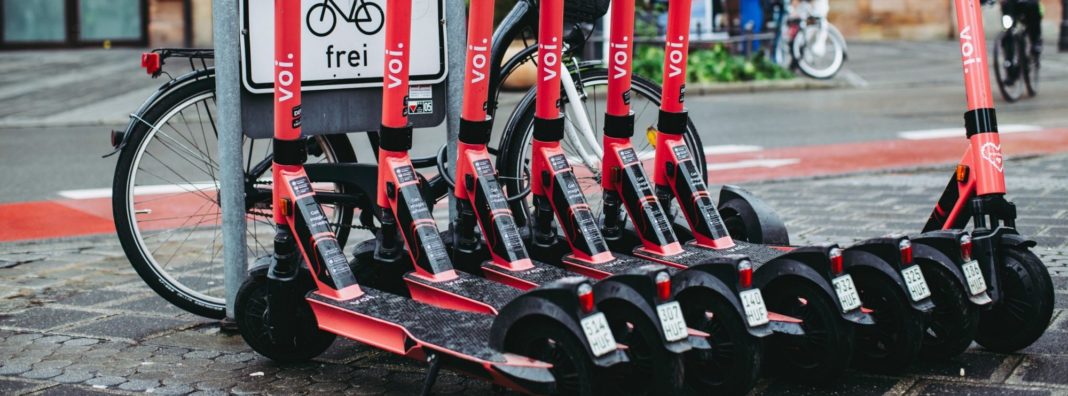
*This is part 2 of a 2 part series on micromobility after COVID. Read part 1 here.
Among its widespread impacts, the COVID-19 pandemic has changed the way we get around. One of the biggest changes has been a decrease in the number of people who use public transportation. With people seeking to avoid exposure to COVID-19, they are opting for personal cars instead of riding buses or trains. Because of this, we expect the number of cars on the streets to rise as cities begin to open up.
But what if the people avoiding transit had other transportation options besides cars? Short car journeys of less than 5 miles can be replaced by micromobility. Shared e-scooters and e-bikes can help commuters move around more easily without fear of contracting coronavirus. Among shared services, micromobility poses the lowest risk of transmitting the disease because it doesn’t require you to ride in a car with someone else.
For micromobility to become a true alternative transportation option for commuters, cities need to change how they regulate shared micromobility. In particular, there are two ways in which cities can encourage shared micromobility companies and help them meet the demands of their customers.
1. Use dynamic caps to regulate the number of vehicles
In most US cities, each micromobility company can only deploy a set amount of scooters or bicycles. With companies allowed only a small number of vehicles, they sometimes struggle to meet demand from users. Users who may want to use an e-bike or an e-scooter are left without any devices around or have to walk long distances to find one.
Instead of setting a hard limit on the number of vehicles each company can operate, cities should set dynamic caps. With dynamic caps, mobility companies start with a set number of vehicles they are allowed to operate but can increase that number depending on their performance. The performance measures vary from city to city. However, they are usually based on criteria such as vehicle ridership, vehicle requirements, equitable distribution of vehicles, mobility studies, and aligning with city goals. For example, if a company can show that each of their vehicles is being used more than three times a day, they can increase their supply of vehicles. In this sense, dynamic caps are an incentive system that rewards operators that perform the best and pushes those who are not to perform better.
Santa Monica was the first city to introduce dynamic caps. Santa Monica originally had a fleet of 2,500 vehicles distributed among four mobility companies. After the introduction of dynamic caps, the number of vehicles in the city increased to 3,250. Similarly, St. Louis is an example of a city that uses dynamic caps for its bike share. The city started with a pilot program of 500 bikes. Every month, companies could add 350 bikes to each fleet, until they reached a maximum of 2,500. After reaching 2,500, companies could expand their fleet if they could demonstrate rising demand for their bikes and had an education and social equity plan.
Regulating the number of micromobility vehicles might not be necessary at all. But if cities want to limit the number of vehicles in the streets, then dynamic caps are better than hard caps. Hard caps stunt micromobility growth. They punish both users and mobility companies. Users find it harder to find bikes and scooters, while mobility companies find it harder to expand. With dynamic caps, user demand can be determined, and companies can expand their fleets without flooding the market all at once. As in St. Louis, cities should start with a small fleet number to test the waters and grow based on demand.
2) Allow more competition among mobility companies
Many US cities limit the number of e-scooter and bike-share companies that can operate within the city. Usually, cities select a couple of operators that apply for permits in each city based on pre-selected criteria. The criteria typically include innovation, safety, labor practices, and accessibility, among others. What it does not include is the demand for each company’s vehicles.
Last year, Washington, DC, announced that it would expand its micromobility pilot program. However, it also announced that it would reduce the number of mobility operators by half. To decide who would get to operate in the city, it requested applications and scored applicants based on specific criteria. Out of the 19 applications it received, only four were granted permits. Some of DC’s popular e-scooter companies did not make the cut, including Lime and Bird. Ultimately, DC’s pick led the other companies to appeal, delaying the implementation of the program.
Limiting the number of companies that can operate in a city reduces competition among mobility companies. If we look at simple economics, more supply leads to lower prices. As consumers, we want more scooter companies, not fewer.
Some cities are already taking a step to allow for more operators. Take, for example, Minneapolis. Scooters are planning to make their comeback to Minneapolis in July after a City Council vote takes place. Originally, Minneapolis was planning to accept only two operators, after a City Council vote: Bird and Lyft. Yet, due to COVID challenges, the city is revising this and is now planning to approve six scooter vendors. Minneapolis is choosing the operators after scoring applications using criteria of safety, equity, and efforts to increase transportation options. While six operators may still not be enough, it beats having only two options.
Cities should allow more competition among micromobility companies simply by allowing more of them to operate. Instead of allowing only a fixed number of companies chosen by a board to operate, cities should allow consumers to decide what companies they like best. Some people might prefer Razor’s seated e-scooter with a basket case, a credit payment system like Bird’s, or a scooter that is connected to your ride-sharing apps like Uber and Lyft. There is an e-scooter or e-bike out there for everyone’s unique preferences. Instead of limiting options, cities should be giving commuters more to choose from.
Micromobility is the future
Micromobility can play an important role as cities begin to reopen. People will begin to look for better, safer, and more efficient options to move around. Shared e-scooters, bikes, and e-bikes can be an alternative to those who do not wish to commute by public transit or car. Yet for micromobility to become a viable transportation option for all, cities need to change the way they regulate these shared services. The current regulations do not allow for this industry to grow to its full potential, and sometimes even hinder further innovation. Instead, cities should be striving to make micromobility more accessible to everyone and help create a more dynamic industry. As cities continue to reopen, now is the time to reform regulations to allow residents to take advantage of the full potential of micromobility.

